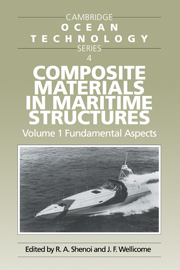Book contents
- Frontmatter
- Contents
- Preface
- List of Authors
- 1 A Strategic Overview
- 2 Background to Materials Science
- 3 Environmental Aspects
- 4 Production by Resin Transfer Moulding
- 5 An Engineering Approach to the Prediction of Elastic Properties of a Laminate
- 6 Mechanics of Orthotropic Laminae
- 7 Analysis of Laminated Composites
- 8 Theory of Sandwich Beams and Plates
- 9 Design of Anisotropic Panels
- 10 Finite Element Analysis of Composites
- 11 Theoretical Predictions of Failure Mechanisms and Strength
- 12 Considerations of Failure Theories in Design
- 13 The Procedures and Standards
- Appendix
- Index
1 - A Strategic Overview
Published online by Cambridge University Press: 04 August 2010
- Frontmatter
- Contents
- Preface
- List of Authors
- 1 A Strategic Overview
- 2 Background to Materials Science
- 3 Environmental Aspects
- 4 Production by Resin Transfer Moulding
- 5 An Engineering Approach to the Prediction of Elastic Properties of a Laminate
- 6 Mechanics of Orthotropic Laminae
- 7 Analysis of Laminated Composites
- 8 Theory of Sandwich Beams and Plates
- 9 Design of Anisotropic Panels
- 10 Finite Element Analysis of Composites
- 11 Theoretical Predictions of Failure Mechanisms and Strength
- 12 Considerations of Failure Theories in Design
- 13 The Procedures and Standards
- Appendix
- Index
Summary
INTRODUCTION TO PLASTICS
The earliest known plastic-moulding techniques were practised by Malayan natives in the early 1800s. They made utensils and artifacts from gum elastic (a vegetable material named gutta percha), softened in hot water and fashioned by hand.
The first synthetic plastic material produced was celluloid. Cellulose nitrate was first produced in 1835 by dissolving cellulosic products in nitric acid. Ten years later, a Swiss chemist by the name of Schonbein nitrated cellulose with sulphuric acid as a catalyst, and in 1854 an American scientist, J. Cutting, obtained patents for his process of gum camphor in collodion for photographic solutions. This marked the first use of camphor with cellulose nitrate. Evaporation of the photographic collodion by Alexander Parkes, an English scientist, produced a hard, elastic waterproof material that could be fashioned into useful articles.
Celluloid, although the first synthetic material, did not advance the moulded products industry as it could not be moulded. Shellacs and bituminous cold-mould plastics continued to dominate the industry until 1909, which marked the introduction of phenol-formaldehyde. Dr Bakeland is accredited with invention of phenol-formaldehyde resin, which was the first synthetic, mouldable plastic material. Since its debut, more than 50 distinct families of plastics have been invented with literally hundreds of variations of these materials. Table 1.1 summarises the major developments in the plastics field up to 1909.
Today, when reference is made to engineering plastics, those most frequently thought of are the acetals, nylons, phenolics, polycarbonates and fluorocarbons. The growth rate of plastics in industrial and commercial usage surpasses most conventional materials such as metals, rubber and ceramics.
- Type
- Chapter
- Information
- Composite Materials in Maritime Structures , pp. 1 - 15Publisher: Cambridge University PressPrint publication year: 1993

